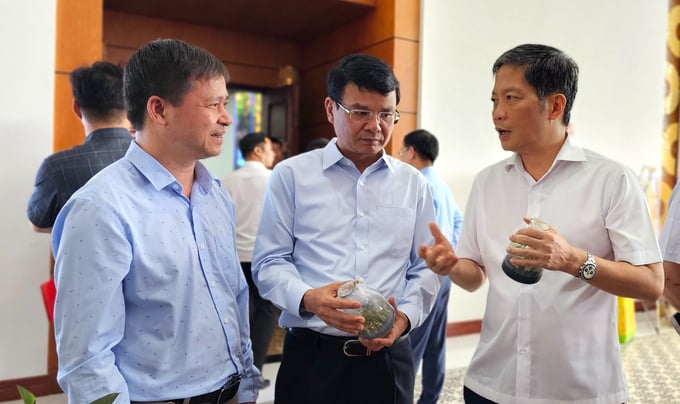May 18, 2025 | 21:10 GMT +7
May 18, 2025 | 21:10 GMT +7
Hotline: 0913.378.918
May 18, 2025 | 21:10 GMT +7
Hotline: 0913.378.918

Mr. Tran Tuan Anh, Member of the Politburo, Head of the Central Economic Commission, giving a speech at the conference. Photo: Hai Dang.
The Central Economic Commission coordinated with the Ministry of Agriculture and Rural Development and the Lao Cai Party Committee to organize a conference on May 9. The conference focused on the "Preliminary review of the 5-year implementation plan for the Central Directive No. 13-CT/TW on strengthening the leadership of the Party in the management, protection and development of forests in the Northern Midlands and Mountains".
Mr. Tran Tuan Anh, Member of the Politburo, is the Head of the Central Economic Commission and Head of the Steering Committee for the aforementioned preliminary review. He reported that the region has actively implemented the Party's guidelines on forest management, protection and development. The implementation of Directive No. 13-CT/TW has yielded numerous positive effects, including a significant shift in public perception and a greater feeling of civic accountability throughout society.
The forestry sector has made great progress in affirming its role in the region's socio-economic development by improving people's lives. The planted forest area has increased. Natural forest areas, forest ecosystems and biodiversity are well protected. The forest coverage rate is 0.6% higher than it was before the issuance of Directive 13 and 12% higher than the national average (54.2%). The wood and non-timber forest product processing industry have developed remarkably. Multiple mechanisms and policies on forestry development have been improved.
The region has made great efforts in overcoming the limitations indicated in Directive No. 13-CT/TW. However, there are still constraints and issues that must be overcome.

Mr. Tran Tuan Anh (right) having a discussion with the participants of the conference. Photo: Hai Dang.
At the conference, local governments in the Northern Midlands and Mountains presented a 5-year summary report on the implementation of Directive No. 13-CT/TW. These reports include an assessment of the results, limitations and the causes for such limitations in localities' implementation of the Directive. Additionally, local leaders proposed key tasks and solutions to strengthen the Party's leadership in forest management, protection and development.
Mr. Tran Tuan Anh agreed with the recommendations and proposals. He also highlighted several key contents:
Firstly, improve the effectiveness and efficiency of state agencies in forest management, protection and development; eliminate backlogs and obstacles in the management and use of forestry land originating from state-owned agro-forestry businesses; handle free immigration issues.
Secondly, establish comprehensive mechanisms and policies to develop forest economy, renew investment policies, and provide investment incentives for forest management, protection and development; develop forestry infrastructure towards production and processing of wood and wood products; develop ecotourism in association with forest protection and development.
Thirdly, implement solutions to enhance the effectiveness of policies on payment for forest environmental services; develop forest environmental services towards sustainability; finalize mechanisms and policies for the carbon credit market in Vietnam.
Fourthly, protect the existing forest area, with emphasis on special-use forests, protection forests and natural forests; strive to achieve zero net emissions by 2050 according to international commitments at COP26 on climate change.
Fifthly, apply new scientific and technological achievements in forest management, protection and development. It is necessary to have effective policies to promote the development of scientific research activities in the field of forestry, with special attention to seed, afforestation, non-timber forest products, mechanization in forestry, and processing of wood products.
Sixthly, create sustainable employment for farmers in forested areas.
Seventhly, promote international cooperation and integration in the field of forest management, protection and development.
The Northern Midlands and Mountains region includes 14 provinces, totalling to over 95 thousand square kilometers (accounting for 28.75% of nation's total land area. The region houses a population of nearly 12 million people (accounting for 12.93% of the country's population). The forested land area is nearly 5.4 million hectares, accounting for 37% of the country's forested land area. Accordingly, the forest coverage rate is 54.02%, which is significantly higher than the national average of 42%. Seven provinces share their borders with Laos and China. This region has an important position in terms of national economy - society, security - defense. It also plays a decisive role in the ecological environment of Northern Vietnam. The region possesses great potential and advantages in agriculture, forestry, hydroelectricity, minerals, tourism and border gate economy.
However, the region has many disadvantaged provinces: only one province reported a per capita income above the national average. Namely, Thai Nguyen province reported a GRDP of 4,831USD/person/year in 2022. Seven provinces are in the group of 10 provinces with the lowest income per capita in the country. Additionally, the area is home to ethnic minorities representing approximately 30 different ethnic groups. Infrastructure development is stagnant.
Translated by Nguyen Hai Long

(VAN) 14 out of 35 domesticated elephants in Dak Lak province have had their living conditions improved, with 11 of them currently participating in the non-riding elephant tourism model.

(VAN) Muong Nhe Nature Reserve hopes that being upgraded to a national park will lay the foundation for forest protection efforts to be carried out in a systematic, modern, and sustainable manner.
/2025/05/16/3923-2-171845_52.jpg)
(VAN) Lower costs, higher yields, and improved soil quality are outstanding benefits that soybeans bring when integrated into the crop rotation system.

(VAN) The 'For a Green National Environment' programme aims to promote a green lifestyle, support businesses in implementing ESG practices, and turn Net Zero commitments into concrete actions.

(VAN) Cold-barn systems efficiently manage environmental and temperature conditions, which aids in the prevention of respiratory diseases in pigs and protects them from the vectors that transmit African swine fevers.

(VAN) To tackle challenges, the project 'Addressing key technical bottlenecks in the grouper supply chain in Vietnam' has been underway since 2024.

(VAN) The project 'Disease-Resilient and Sustainable Cassava Production Systems in the Mekong Region', funded by the Australian Center for International Agricultural Research (ACIAR), is being implemented from 2024 to 2028.